Coordination Analysis of Sustainable Agricultural Development in Northeast China from the Perspective of Spatiotemporal Relationships
Abstract
:1. Introduction
2. Materials and Methods
2.1. Research Methods
2.1.1. Framework of Sustainable Agricultural Development
2.1.2. Evaluation Index System Construction and Comprehensive Index Calculation
2.1.3. Coupling Coordination Degree Analysis
2.1.4. Exploratory Spatial Data Analysis Methods
2.2. Research Area
2.3. Data Sources
3. Results
3.1. Evolutionary Characteristics of Agricultural Sustainable Pattern
3.1.1. Agricultural Sustainable Development System
3.1.2. Economic Subsystem
3.1.3. Social Subsystem
3.1.4. Resource Subsystem
3.1.5. Technology Subsystem
3.2. Coordination Degree of Sustainable Agricultural Development System
3.3. Spatiotemporal Agglomeration Characteristics of Sustainable Agricultural Development
3.3.1. Global Autocorrelation Analysis
3.3.2. Local Autocorrelation Analysis
4. Discussion
4.1. Interpretation of the Findings of Sustainable Agricultural Development
4.2. Comparison with Previous Studies
4.3. Agricultural Policy Optimization
5. Conclusions
Author Contributions
Funding
Institutional Review Board Statement
Informed Consent Statement
Data Availability Statement
Conflicts of Interest
References
- Verburg, P.H.; Crossman, N.; Ellis, E.C.; Heinimann, A.; Hostert, P.; Mertz, O.; Nagendra, H.; Sikor, T.; Erb, K.-H.; Golubiewski, N.; et al. Land System Science and Sustainable Development of the Earth System: A Global Land Project Perspective. Anthropocene 2015, 12, 29–41. [Google Scholar] [CrossRef]
- Ehrensperger, A.; de Bremond, A.; Providoli, I.; Messerli, P. Land System Science and the 2030 Agenda: Exploring Knowledge That Supports Sustainability Transformation. Curr. Opin. Environ. Sustain. 2019, 38, 68–76. [Google Scholar] [CrossRef]
- Caron, P.; Ferrero y de Loma-Osorio, G.; Nabarro, D.; Hainzelin, E.; Guillou, M.; Andersen, I.; Arnold, T.; Astralaga, M.; Beukeboom, M.; Bickersteth, S.; et al. Food Systems for Sustainable Development: Proposals for a Profound Four-Part Transformation. Agron. Sustain. Dev. 2018, 38, 41. [Google Scholar] [CrossRef]
- Sustainable Food and Agriculture. Available online: http://www.fao.org/sustainability/en/ (accessed on 2 October 2023).
- Byerlee, D.; De Janvry, A.; Sadoulet, E. Agriculture for Development: Toward a New Paradigm. Annu. Rev. Resour. Econ. 2009, 1, 15–31. [Google Scholar] [CrossRef]
- Reganold, J.P.; Jackson-Smith, D.; Batie, S.S.; Harwood, R.R.; Kornegay, J.L.; Bucks, D.; Flora, C.B.; Hanson, J.C.; Jury, W.A.; Meyer, D.; et al. Transforming U.S. Agriculture. Science 2011, 332, 670–671. [Google Scholar] [CrossRef] [PubMed]
- Khojasteh, D.; Davani, E.; Shamsipour, A.; Haghani, M.; Glamore, W. Climate Change and COVID-19: Interdisciplinary Perspectives from Two Global Crises. Sci. Total Environ. 2022, 844, 157142. [Google Scholar] [CrossRef] [PubMed]
- Tracking Progress on Food and Agriculture-SDG Indicators 2023. Available online: https://www.fao.org/3/cc7088en/online/cc7088en.html (accessed on 27 September 2023).
- Ding, Y.-X.; Zhang, S.; Xu, R.; Gao, Y.; Ding, H.; Sun, P.; Liu, W. The Coupling Coordination Measurement, Spatio-Temporal Differentiation and Driving Mechanism of Urban and Rural Water Poverty in Northwest China. Int. J. Environ. Res. Public Health 2023, 20, 2043. [Google Scholar] [CrossRef] [PubMed]
- Wei, X.; Liu, L.; Yuan, C.; Xia, Z. Determining Urban–rural Coordinated Development in Major Grain-Producing Areas Based on Urbanization and Cultivated Land Use Efficiency Coordination Level: A Case Study in Hunan Province, China. Front. Environ. Sci. 2023, 10, 1091898. [Google Scholar] [CrossRef]
- Zhang, Y.; Wei, T.; Tian, W.; Zhao, K. Spatiotemporal Differentiation and Driving Mechanism of Coupling Coordination between New-Type Urbanization and Ecological Environment in China. Sustainability 2022, 14, 11780. [Google Scholar] [CrossRef]
- Liu, J.; Mooney, H.; Hull, V.; Davis, S.; Gaskell, J.; Hertel, T.; Lubchenco, J.; Seto, K.; Gleick, P.; Kremen, C.; et al. Systems Integration for Global Sustainability. Science 2015, 347, 1258832. [Google Scholar] [CrossRef] [PubMed]
- Full Transcript of Policy Briefing of the State Council on March 20, 2015. Available online: http://english.www.gov.cn/news/policy_briefings/2015/03/20/content_281475074650908.htm (accessed on 28 September 2023).
- Cheng, H.; Wang, X.; Chen, D. Research on Spatial-Temporal Variations of Cultivated Land in China Based on GlobeLand30. Front. Environ. Sci. 2022, 10, 929760. [Google Scholar] [CrossRef]
- Bai, Y.; Zhai, Y.; Ji, C.; Zhang, T.; Chen, W.; Shen, X.; Hong, J. Environmental Sustainability Challenges of China’s Edible Vegetable Oil Industry: From Farm to Factory. Resour. Conserv. Recycl. 2021, 170, 105606. [Google Scholar] [CrossRef]
- Jiang, L.; Li, Z. Urbanization and the Change of Fertilizer Use Intensity for Agricultural Production in Henan Province. Sustainability 2016, 8, 186. [Google Scholar] [CrossRef]
- Wu, S.; Li, L.; Li, S. Natural Resource Abundance, Natural Resource-Oriented Industry Dependence, and Economic Growth: Evidence from the Provincial Level in China. Resour. Conserv. Recycl. 2018, 139, 163–171. [Google Scholar] [CrossRef]
- Sun, F.; Wang, L.; Cao, S.; Zhang, Y. How Farmland Circulation Affects Household Financial Vulnerability in China: The Chain Mediation Effect of Labor Transfer and Financial Literacy. Front. Sustain. Food Syst. 2023, 7, 1102189. [Google Scholar] [CrossRef]
- Wang, M.; Xu, X.; Zheng, L.; Xu, X.; Zhang, Y. Analysis of the Relationship between Economic Development and Water Resources–Ecological Management Capacity in China Based on Nighttime Lighting Data. Int. J. Environ. Res. Public Health 2023, 20, 1818. [Google Scholar] [CrossRef] [PubMed]
- Kuang, B.; Lu, X.; Zhou, M.; Chen, D. Provincial Cultivated Land Use Efficiency in China: Empirical Analysis Based on the SBM-DEA Model with Carbon Emissions Considered. Technol. Forecast. Soc. Chang. 2020, 151, 119874. [Google Scholar] [CrossRef]
- Aznar-Sánchez, J.A.; Piquer-Rodríguez, M.; Velasco-Muñoz, J.F.; Manzano-Agugliaro, F. Worldwide Research Trends on Sustainable Land Use in Agriculture. Land Use Policy 2019, 87, 104069. [Google Scholar] [CrossRef]
- Yu, S.; Mu, Y. Sustainable Agricultural Development Assessment: A Comprehensive Review and Bibliometric Analysis. Sustainability 2022, 14, 11824. [Google Scholar] [CrossRef]
- Selecting Weighting Methodologies for Evaluating Agricultural Sustainability in Iran|Proceedings of the Institution of Civil Engineers—Engineering Sustainability. Available online: https://www.icevirtuallibrary.com/doi/10.1680/jensu.18.00004 (accessed on 30 September 2023).
- Guo, H.; Xu, S.; Pan, C. Measurement of the Spatial Complexity and Its Influencing Factors of Agricultural Green Development in China. Sustainability 2020, 12, 9259. [Google Scholar] [CrossRef]
- Fallah-Alipour, S.; Mehrabi Boshrabadi, H.; Zare Mehrjerdi, M.R.; Hayati, D. A Framework for Empirical Assessment of Agricultural Sustainability: The Case of Iran. Sustainability 2018, 10, 4823. [Google Scholar] [CrossRef]
- Sulewski, P.; Kłoczko-Gajewska, A.; Sroka, W. Relations between Agri-Environmental, Economic and Social Dimensions of Farms’ Sustainability. Sustainability 2018, 10, 4629. [Google Scholar] [CrossRef]
- Food and Agriculture Organization of the United Nations. Available online: http://www.fao.org/sustainability/background/en/?key=5 (accessed on 30 September 2023).
- Liu, X.; Xin, Y. Exploring the Characteristics and Driving Factors of Coupling Coordination of Regional Sustainable Development: Evidence from China’s 31 Provinces. Environ. Sci. Pollut. Res. 2022, 29, 71075–71099. [Google Scholar] [CrossRef] [PubMed]
- Ge, Y.; Hu, S.; Song, Y.; Zheng, H.; Liu, Y.; Ye, X.; Ma, T.; Liu, M.; Zhou, C. Sustainable Poverty Reduction Models for the Coordinated Development of the Social Economy and Environment in China. Sci. Bull. 2023, 68, 2236–2246. [Google Scholar] [CrossRef]
- Liang, X.; Si, D.; Zhang, X. Regional Sustainable Development Analysis Based on Information Entropy—Sichuan Province as an Example. Int. J. Environ. Res. Public Health 2017, 14, 1219. [Google Scholar] [CrossRef] [PubMed]
- Sabaghi, M.; Mascle, C.; Baptiste, P.; Rostamzadeh, R. Sustainability Assessment Using Fuzzy-Inference Technique (SAFT): A Methodology toward Green Products. Expert. Syst. Appl. 2016, 56, 69–79. [Google Scholar] [CrossRef]
- Li, B.; Feng, Y.; Xia, X.; Feng, M. Evaluation of China’s Circular Agriculture Performance and Analysis of the Driving Factors. Sustainability 2021, 13, 1643. [Google Scholar] [CrossRef]
- Chen, Z.; Li, X.; Xia, X. Measurement and Spatial Convergence Analysis of China’s Agricultural Green Development Index. Environ. Sci. Pollut. Res. 2021, 28, 19694–19709. [Google Scholar] [CrossRef]
- Li, M.; Wang, J.; Chen, Y. Evaluation and Influencing Factors of Sustainable Development Capability of Agriculture in Countries along the Belt and Road Route. Sustainability 2019, 11, 2004. [Google Scholar] [CrossRef]
- Liu, Y.; Sun, D.; Wang, H.; Wang, X.; Yu, G.; Zhao, X. An Evaluation of China’s Agricultural Green Production: 1978–2017. J. Clean. Prod. 2020, 243, 118483. [Google Scholar] [CrossRef]
- Aguilar-Rivera, N. A Framework for the Analysis of Socioeconomic and Geographic Sugarcane Agro Industry Sustainability. Socio-Econ. Plan. Sci. 2019, 66, 149–160. [Google Scholar] [CrossRef]
- Lin, C.-N. A Fuzzy Analytic Hierarchy Process-Based Analysis of the Dynamic Sustainable Management Index in Leisure Agriculture. Sustainability 2020, 12, 5395. [Google Scholar] [CrossRef]
- Tzouramani, I.; Mantziaris, S.; Karanikolas, P. Assessing Sustainability Performance at the Farm Level: Examples from Greek Agricultural Systems. Sustainability 2020, 12, 2929. [Google Scholar] [CrossRef]
- Sajadian, M.; Khoshbakht, K.; Liaghati, H.; Veisi, H.; Mahdavi Damghani, A. Developing and Quantifying Indicators of Organic Farming Using Analytic Hierarchy Process. Ecol. Indic. 2017, 83, 103–111. [Google Scholar] [CrossRef]
- Wang, Y.; Cai, Y.; Liu, G.; Zhang, P.; Li, B.; Li, B.; Jia, Q.; Huang, Y.; Shu, T. Evaluation of Sustainable Crop Production from an Ecological Perspective Based Emergy Analysis: A Case of China’s Provinces. J. Clean. Prod. 2021, 313, 127912. [Google Scholar] [CrossRef]
- Suresh, A.; Krishnan, P.; Jha, G.K.; Reddy, A.A. Agricultural Sustainability and Its Trends in India: A Macro-Level Index-Based Empirical Evaluation. Sustainability 2022, 14, 2540. [Google Scholar] [CrossRef]
- Wang, H.; Wang, J.; Shi, B. Model and Application of Green Industry Evaluation Based on Fuzzy Control. J. Intell. Fuzzy Syst. 2015, 29, 2489–2494. [Google Scholar] [CrossRef]
- Feng, K.; Zheng, J.; Wei, S.; Zheng, W.; Liu, Y. Spatial Difference of Urban Land Intensive Use Based on the GIS and PSR Model-a Case Study of Zhejiang Province. Econ. Geogr. 2007, 27, 5. [Google Scholar] [CrossRef]
- Gao, S.; Huang, X. Performance Evaluation of Eco-Construction Based on PSR Model in China from 1953 to 2008. J. Nat. Resour. 2010, 25, 341–350. [Google Scholar] [CrossRef]
- Li, Q.; Hu, S.; Qu, S. Evolution and Coordination of Spatial Pattern of Cultivated Land Management in Hunan Province. Resour. Sci. 2019, 41, 233–246. [Google Scholar] [CrossRef]
- Shi, L.; Han, L.; Yang, F.; Gao, L. The Evolution of Sustainable Development Theory: Types, Goals, and Research Prospects. Sustainability 2019, 11, 7158. [Google Scholar] [CrossRef]
- Hendrickson, J.; Hanson, J.; Tanaka, D.; Sassenrath, G. Principles of Integrated Agricultural Systems: Introduction to Processes and Definition. Renew. Agric. Food Syst. 2008, 23, 265–271. [Google Scholar] [CrossRef]
- Bagheri, A.; Hjorth, P. Planning for Sustainable Development: A Paradigm Shift towards a Process-Based Approach. Sustain. Dev. 2007, 15, 83–96. [Google Scholar] [CrossRef]
- Saifi, B.; Drake, L. A Coevolutionary Model for Promoting Agricultural Sustainability. Ecol. Econ. 2008, 65, 24–34. [Google Scholar] [CrossRef]
- Laurett, R.; Paço, A.; Mainardes, E. Antecedents and Consequences of Sustainable Development in Agriculture and the Moderator Role of the Barriers: Proposal and Test of a Structural Model. J. Rural Stud. 2021, 86, 270–281. [Google Scholar] [CrossRef]
- Laurett, R.; Paço, A.; Mainardes, E. Sustainable Development in Agriculture and Its Antecedents, Barriers and Consequences—An Exploratory Study. Sustain. Prod. Consum. 2020, 27, 298–311. [Google Scholar] [CrossRef]
- Fess, T.L.; Benedito, V. Organic versus Conventional Cropping Sustainability: A Comparative System Analysis. Sustainability 2018, 10, 272. [Google Scholar] [CrossRef]
- Trigo, A.; Marta-Costa, A.; Fragoso, R. Principles of Sustainable Agriculture: Defining Standardized Reference Points. Sustainability 2021, 13, 4086. [Google Scholar] [CrossRef]
- Zsarnóczai, J.S.; Zéman, Z. Output Value and Productivity of Agricultural Industry in Central-East Europe. Agric. Econ. 2019, 65, 185–193. [Google Scholar] [CrossRef]
- Phasinam, K.; Kassanuk, T.; Shabaz, M. Applicability of Internet of Things in Smart Farming. J. Food Qual. 2022, 2022, 7692922. [Google Scholar] [CrossRef]
- Lakshmi, G.J.; Hilmi, S.A.N.; Obaid, A.J. Artificial Intelligence Agriculture Recommendation Model (AIARM). Int. J. Health Sci. 2022, 6, 1782–1808. [Google Scholar] [CrossRef]
- Yang, P.; Zhao, Q.; Cai, X. Machine Learning Based Estimation of Land Productivity in the Contiguous US Using Biophysical Predictors. Environ. Res. Lett. 2020, 15, 074013. [Google Scholar] [CrossRef]
- Coelli, T.; Rao, D. Total Factor Productivity Growth in Agriculture: A Malmquist Index Analysis of 93 Countries, 1980–2000 *. Agric. Econ. 2003, 32, 115–134. [Google Scholar] [CrossRef]
- Huang, G.; Jiang, Y. Urbanization and Socioeconomic Development in Inner Mongolia in 2000 and 2010: A GIS Analysis. Sustainability 2017, 9, 235. [Google Scholar] [CrossRef]
- Jones, G.W.; Visaria, P. Urbanization in Large Developing Countries: China, Indonesia, Brazil and India. Popul. Dev. Rev. 1998, 24, 648–649. [Google Scholar] [CrossRef]
- Young, A. Inequality, the Urban-Rural Gap, and Migration*. Q. J. Econ. 2013, 128, 1727–1785. [Google Scholar] [CrossRef]
- Wan, J.; Su, Y.; Zan, H.; Zhao, Y.; Zhang, L.; Zhang, S.; Dong, X.; Deng, W. Land Functions, Rural Space Governance, and Farmers’ Environmental Perceptions: A Case Study from the Huanjiang Karst Mountain Area, China. Land 2020, 9, 134. [Google Scholar] [CrossRef]
- Feng, K.; Li, Q.; Huang, B.; Yan, H. Research on the Domain and Potential for Further Electrification of Rural Domestic Energy Consumption. IOP Conf. Ser. Mater. Sci. Eng. 2020, 768, 062055. [Google Scholar] [CrossRef]
- Yan, X.; Wang, Y.; Yang, G.; Liao, N.; Li, F. Research on the Scale of Agricultural Land Moderate Management and Countermeasures Based on Farm Household Analysis. Sustainability 2021, 13, 10591. [Google Scholar] [CrossRef]
- Rosa, L. Adapting Agriculture to Climate Change via Sustainable Irrigation: Biophysical Potentials and Feedbacks. Environ. Res. Lett. 2022, 17, 063008. [Google Scholar] [CrossRef]
- Toriman, M.; Mokhtar, M. Irrigation: Types, Sources and Problems in Malaysia. In Irrigation Systems and Practices in Challenging Environments; IntechOpen: London, UK, 2012. [Google Scholar] [CrossRef]
- Li, Q.; Dong, Z.; Du, G.; Yang, A. Spatial Differentiation of Cultivated Land Use Intensification in Village Settings: A Survey of Typical Chinese Villages. Land 2021, 10, 249. [Google Scholar] [CrossRef]
- Bisht, N.; Chauhan, P. Excessive and Disproportionate Use of Chemicals Cause Soil Contamination and Nutritional Stress. In Soil Contamination—Threats and Sustainable Solutions; IntechOpen: London, UK, 2020. [Google Scholar] [CrossRef]
- Gusniar, I.N.; Putra, A.S. Perhitungan Beban Statik Pada Rangka Mesin Pengering Padi Menggunakan Baja AISI 1020. J. Tek. Mesin 2021, 14, 53–58. [Google Scholar] [CrossRef]
- Umamaheswari, S.; Jain, A.V. Encoder–Decoder Architecture for Crop-Weed Classification Using Pixel-Wise Labelling. In Proceedings of the 2020 International Conference on Artificial Intelligence and Signal Processing (AISP), Amaravati, India, 10–12 January 2020; pp. 1–6. [Google Scholar] [CrossRef]
- Zhang, Y.; Xue, W.; Wen, Y.; Wang, X. Sustainability Assessment of Water Resources Use in 31 Provinces in China: A Combination Method of Entropy Weight and Cloud Model. Int. J. Environ. Res. Public Health 2022, 19, 12870. [Google Scholar] [CrossRef] [PubMed]
- Jin, W.; Bian, Z.; Wei, Z.; Wang, S. Multi-Functional Evaluation of Cultivated Land in Peri-Urban Areas of Shenyang City. Chin. J. Agric. Resour. Reg. Plan. 2019, 40, 8. [Google Scholar] [CrossRef]
- Yang, L.; Lin, Y.; Zhu, J.; Yang, K. Dynamic Coupling Coordination and Spatial–Temporal Analysis of Digital Economy and Carbon Environment Governance from Provinces in China. Ecol. Indic. 2023, 156, 111091. [Google Scholar] [CrossRef]
- Dynamic Variation of Ecosystem Services Value under Land Use/Cover Change in the Black Soil Region of Northeastern China. Available online: https://www.citexs.com/Detail?pmid=35742781&title=dynamic%20variation%20of%20ecosystem%20services%20value%20under%20land%20use%2Fcover%20change%20in%20the%20black%20soil%20region%20of%20northeastern%20china (accessed on 4 November 2023).
- Fan, P.; Mishra, A.K.; Feng, S.; Su, M. The Effect of Agricultural Subsidies on Chemical Fertilizer Use: Evidence from a New Policy in China. J. Environ. Manag. 2023, 344, 118423. [Google Scholar] [CrossRef]
- Xiao, S.; He, Z.; Zhang, W.; Qin, X. The Agricultural Green Production Following the Technological Progress: Evidence from China. Int. J. Environ. Res. Public Health 2022, 19, 9876. [Google Scholar] [CrossRef]
- Deng, F.; Liu, C.; Liang, X. Measurement of Regional Agricultural Sustainable Development System Based on Dissipative Structure Theory: A Case Study in Sichuan Province, China. Sustainability 2017, 9, 2047. [Google Scholar] [CrossRef]
- Li, Z. Study on Coordination Development of Science&technology-Economy System in Western Provinces. J. Guangxi Econ. Manag. Cadre Coll. 2014, 28–34. [Google Scholar]
- Niu, J.; Tang, H.; Liu, Q.; Cheng, F.; Zhang, L.; Sang, L.; Huang, Y.; Shen, C.; Gao, B.; Niu, Z. Determinants of Soil Bacterial Diversity in a Black Soil Region in a Large-Scale Area. Land 2022, 11, 731. [Google Scholar] [CrossRef]
- Mockshell, J.; Kamanda, J. Beyond the Agroecological and Sustainable Agricultural Intensification Debate: Is Blended Sustainability the Way Forward? Int. J. Agric. Sustain. 2018, 16, 127–149. [Google Scholar] [CrossRef]
- Bathaei, A.; Štreimikienė, D. A Systematic Review of Agricultural Sustainability Indicators. Agriculture 2023, 13, 241. [Google Scholar] [CrossRef]
- Ajibade, S.; Simon, B.; Gulyas, M.; Balint, C. Sustainable Intensification of Agriculture as a Tool to Promote Food Security: A Bibliometric Analysis. Front. Sustain. Food Syst. 2023, 7, 1101528. [Google Scholar] [CrossRef]
- Pawlak, K.; Kołodziejczak, M. The Role of Agriculture in Ensuring Food Security in Developing Countries: Considerations in the Context of the Problem of Sustainable Food Production. Sustainability 2020, 12, 5488. [Google Scholar] [CrossRef]
- Sun, B.; Luo, Y.; Yang, D.; Yang, J.; Zhao, Y.; Zhang, J. Coordinative Management of Soil Resources and Agricultural Farmland Environment for Food Security and Sustainable Development in China. Int. J. Environ. Res. Public Health 2023, 20, 3233. [Google Scholar] [CrossRef]
- Järnberg, L.; Kautsky, E.; Dagerskog, L.; Olsson, P. Green Niche Actors Navigating an Opaque Opportunity Context: Prospects for a Sustainable Transformation of Ethiopian Agriculture. Land Use Policy 2018, 71, 409–421. [Google Scholar] [CrossRef]
- Taoumi, H.; Lahrech, K. Economic, Environmental and Social Efficiency and Effectiveness Development in the Sustainable Crop Agricultural Sector: A Systematic in-Depth Analysis Review. Sci. Total Environ. 2023, 901, 165761. [Google Scholar] [CrossRef]
- Hou, X.; Yin, Y.; Zhou, X.; Zhao, M.; Yao, L.; Zhang, D.; Wang, X.; Xia, C. Does Economic Agglomeration Affect the Sustainable Intensification of Cultivated Land Use? Evidence from China. Ecol. Indic. 2023, 154, 110808. [Google Scholar] [CrossRef]
- Arvor, D.; Daugeard, M.; Tritsch, I.; Mello-Théry, N.A.; Théry, H.; Dubreuil, V. Combining Socioeconomic Development with Environmental Governance in the Brazilian Amazon: The Mato Grosso Agricultural Frontier at a Tipping Point. Environ. Dev. Sustain. 2018, 20, 1–22. [Google Scholar] [CrossRef]
- Rezaei-Moghaddam, K.; Karami, E. A Multiple Criteria Evaluation of Sustainable Agricultural Development Models Using AHP. Environ. Dev. Sustain. 2008, 10, 407–426. [Google Scholar] [CrossRef]
- Cheng, J.; Xu, Z.; Liang, Z.; Li, F.; Cong, W.-F.; Zhang, C.; Song, L.; Wang, C.; Zhang, F.; Richter, A.; et al. Farmers Perceive Diminishing Ecosystem Services, but Overlook Dis-Services in Intensively Used Agricultural Landscapes in the North China Plain. J. Environ. Manag. 2023, 347, 119060. [Google Scholar] [CrossRef] [PubMed]
- Guo, H.; Zhao, W.; Pan, C.; Qiu, G.; Xu, S.; Liu, S. Study on the Influencing Factors of Farmers’ Adoption of Conservation Tillage Technology in Black Soil Region in China: A Logistic-ISM Model Approach. Int. J. Environ. Res. Public Health 2022, 19, 7762. [Google Scholar] [CrossRef]
- Qu, Y.; Pan, C.; Guo, H. Factors Affecting the Promotion of Conservation Tillage in Black Soil—The Case of Northeast China. Sustainability 2021, 13, 9563. [Google Scholar] [CrossRef]
- Huang, J.; Yang, G. Understanding Recent Challenges and New Food Policy in China. Glob. Food Secur. 2017, 12, 119–126. [Google Scholar] [CrossRef]
- Zhang, Q.; Qu, Y.; Zhan, L. Great Transition and New Pattern: Agriculture and Rural Area Green Development and Its Coordinated Relationship with Economic Growth in China. J. Environ. Manag. 2023, 344, 118563. [Google Scholar] [CrossRef] [PubMed]
- Khan, M.A.; Tahir, A.; Khurshid, N.; Husnain, M.; Ahmed, M.; Boughanmi, H. Economic Effects of Climate Change-Induced Loss of Agricultural Production by 2050: A Case Study of Pakistan. Sustainability 2020, 12, 1216. [Google Scholar] [CrossRef]
- Roy, R.; Chan, N.W.; Xenarios, S. Sustainability of Rice Production Systems: An Empirical Evaluation to Improve Policy. Environ. Dev. Sustain. 2016, 18, 257–278. [Google Scholar] [CrossRef]
- Wang, C. China’s Energy Policy and Sustainable Energy Transition for Sustainable Development: Green Investment in Renewable Technological Paradigm. Environ. Sci. Pollut. Res. 2023, 30, 51491–51503. [Google Scholar] [CrossRef]
- Cheng, L.; Gao, Y.; Dai, X. Spatio-Temporal Comprehensive Measurement of China’s Agricultural Green Development Level and Associated Influencing Factors. PLoS ONE 2023, 18, e0288599. [Google Scholar] [CrossRef]
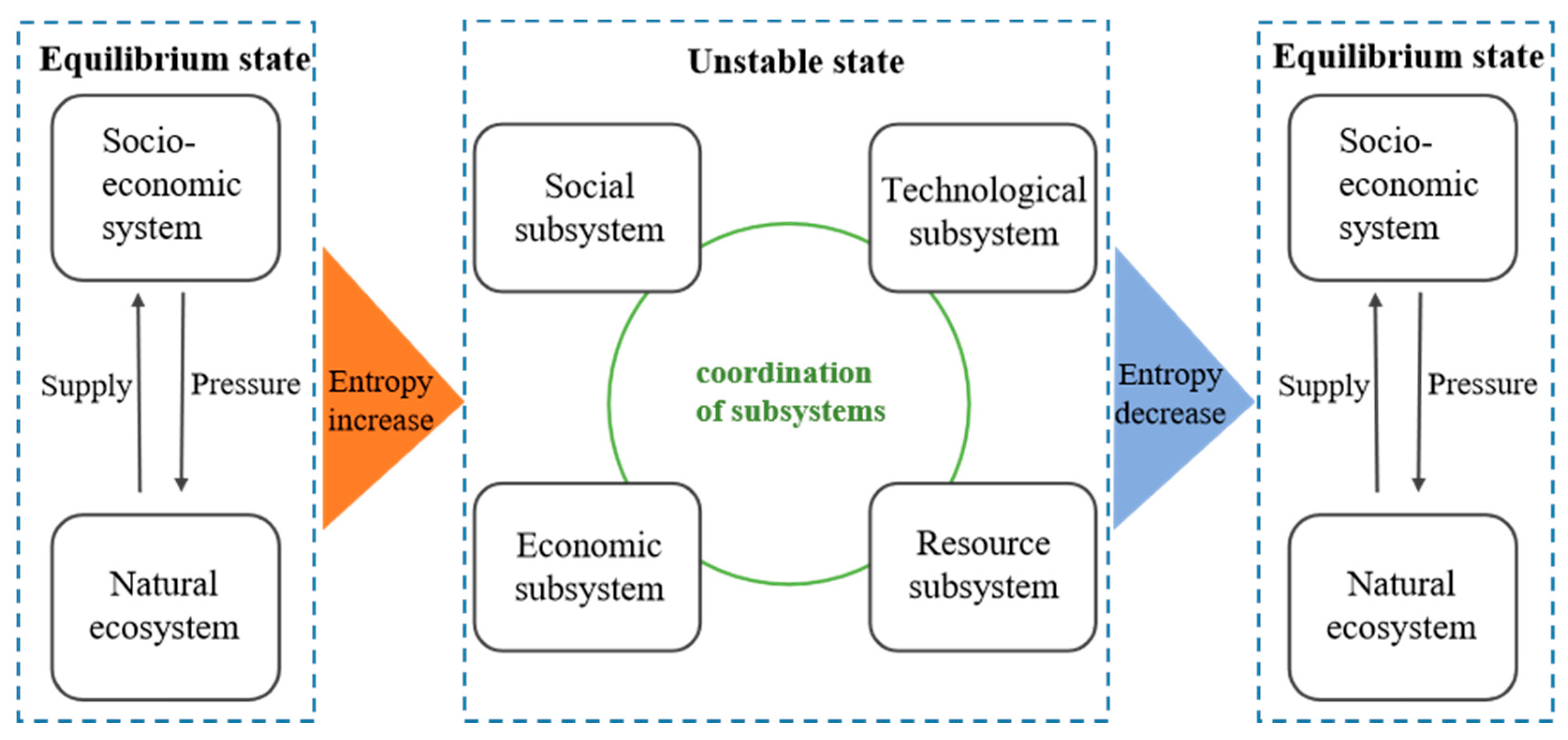
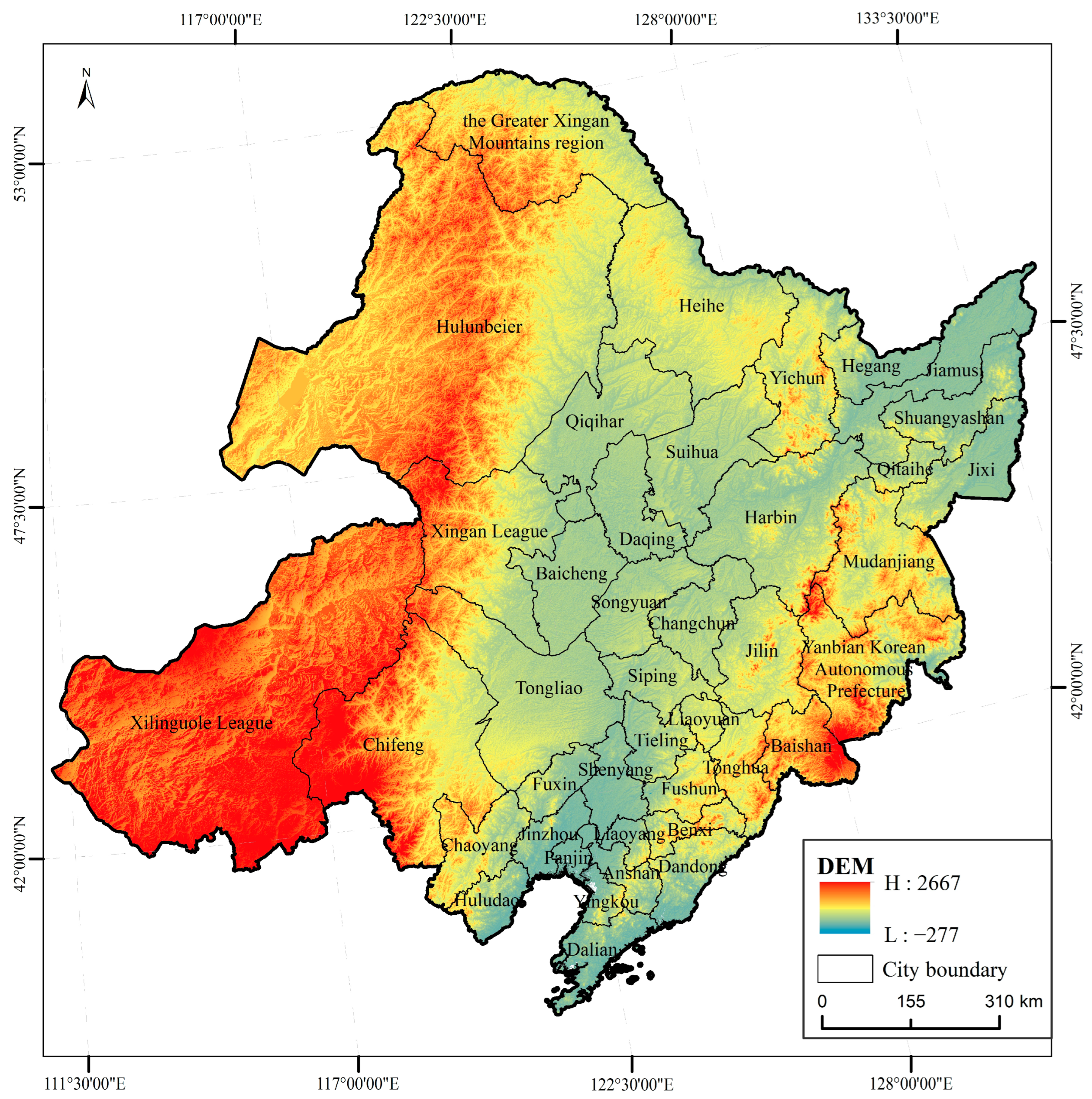
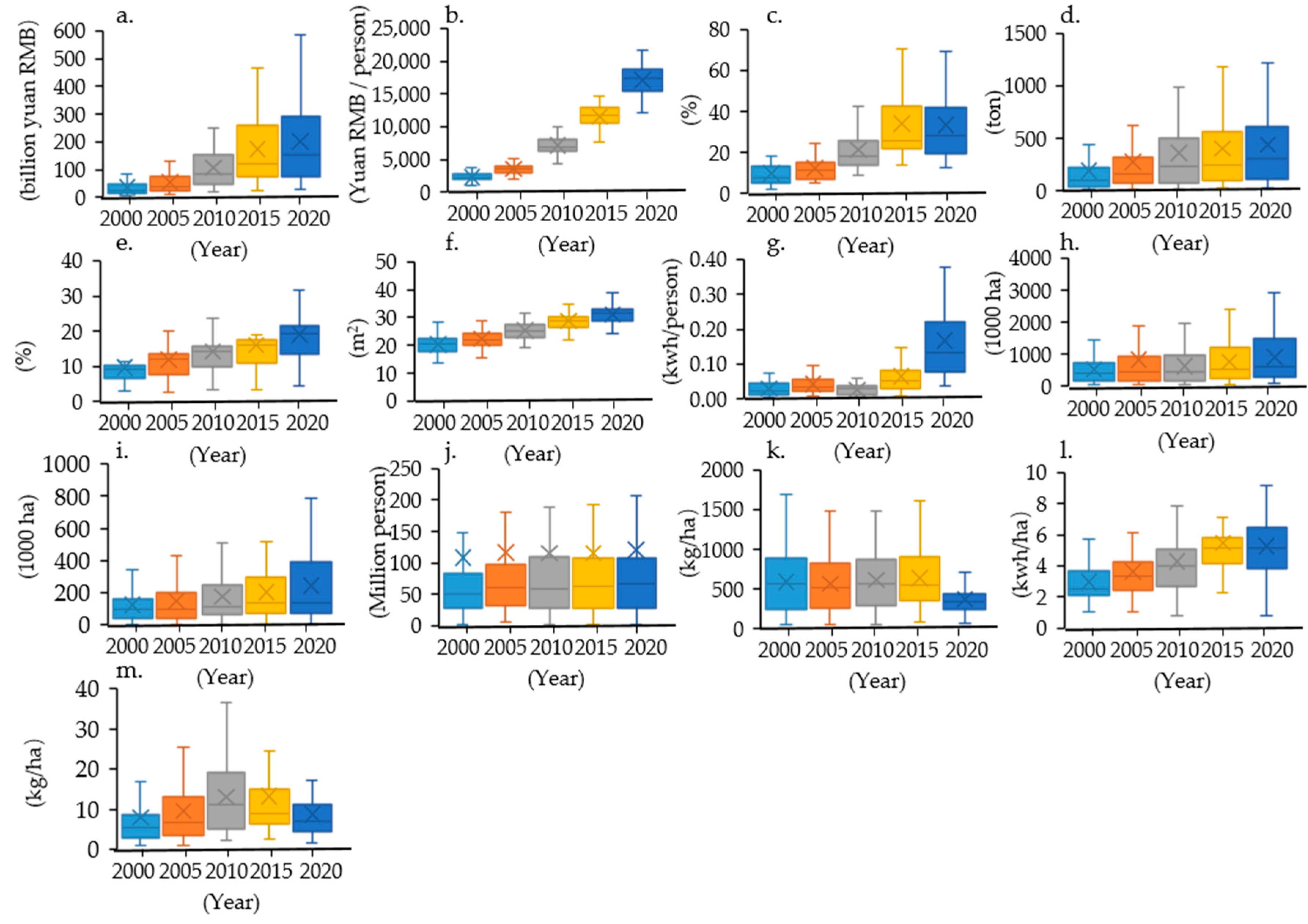

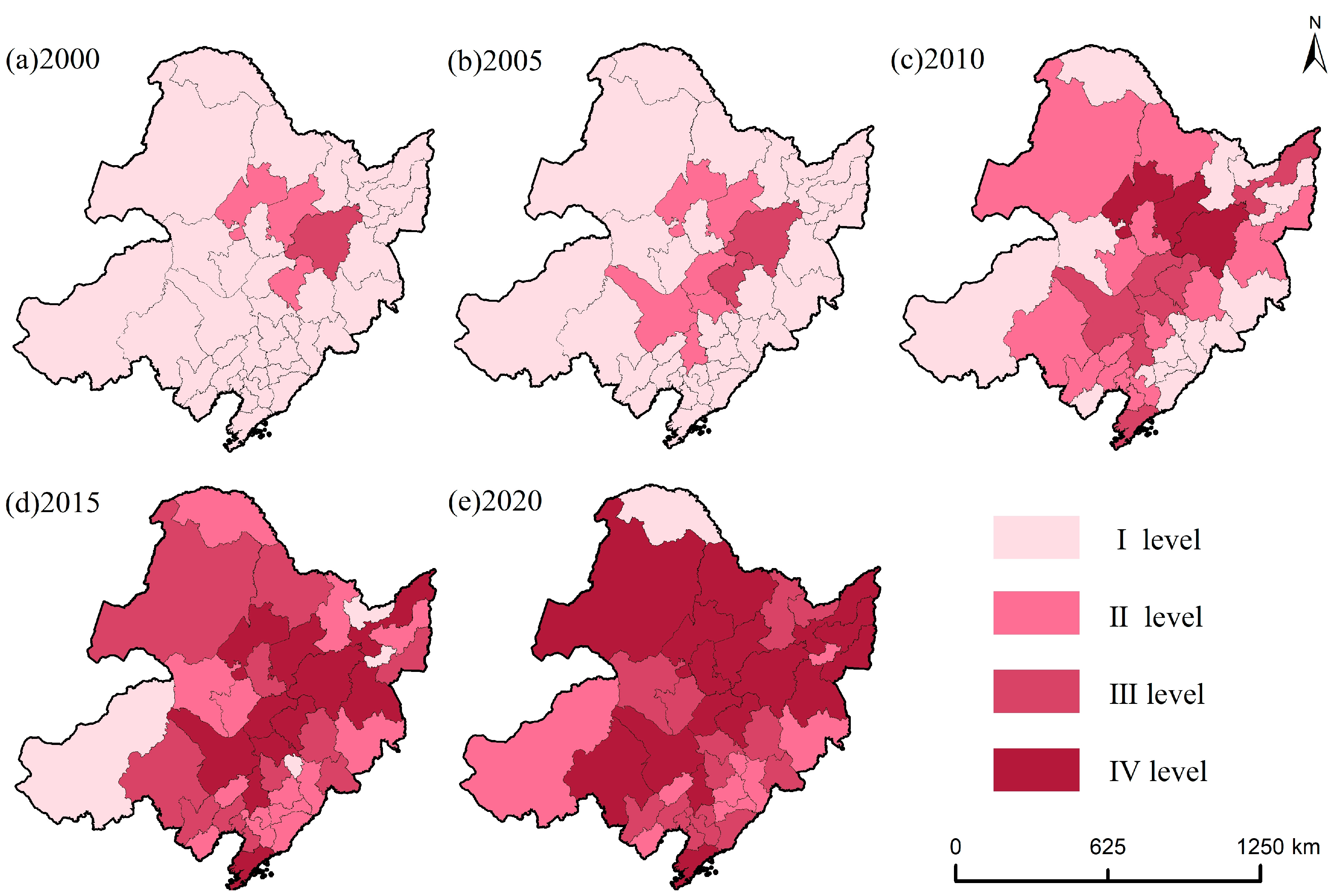
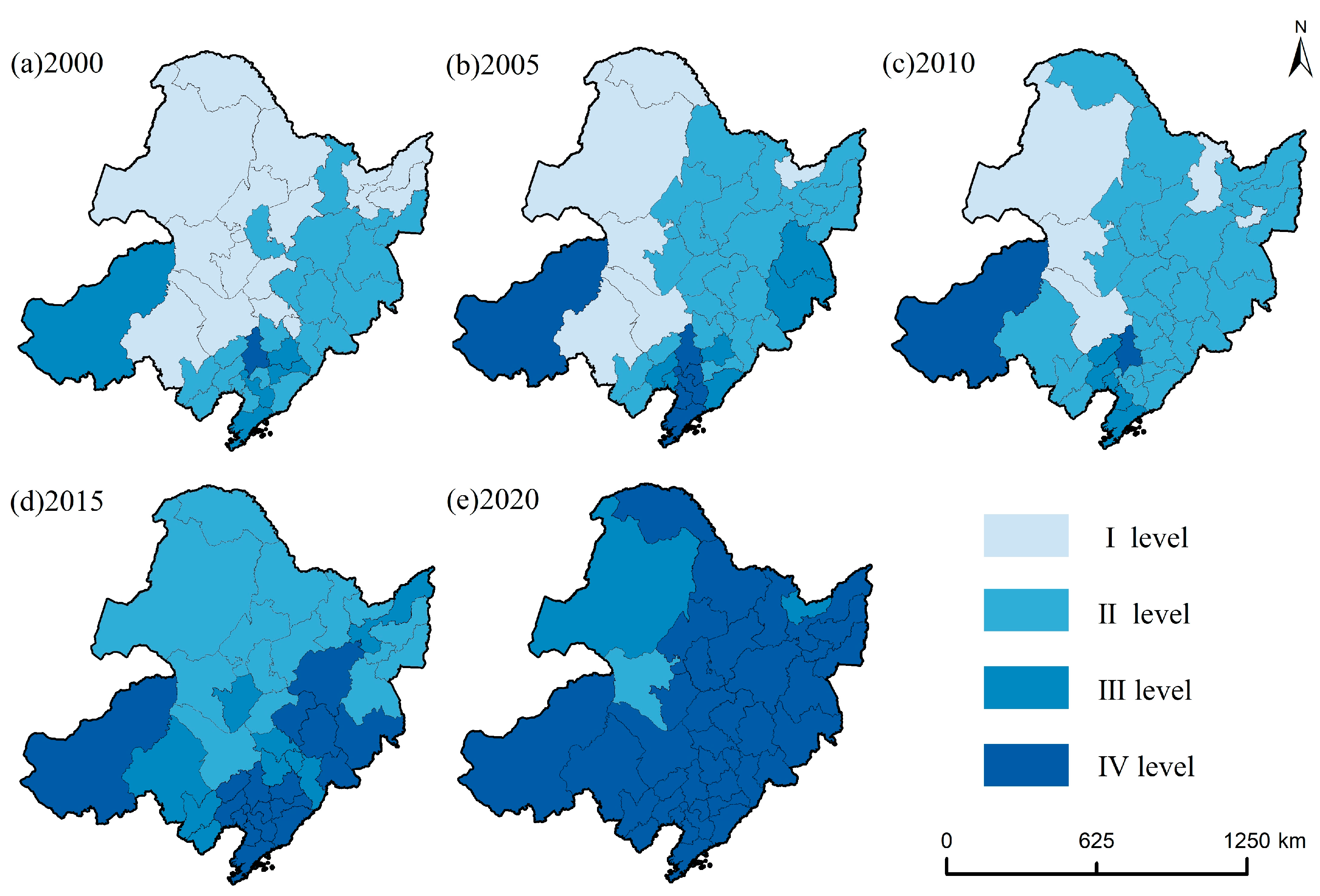
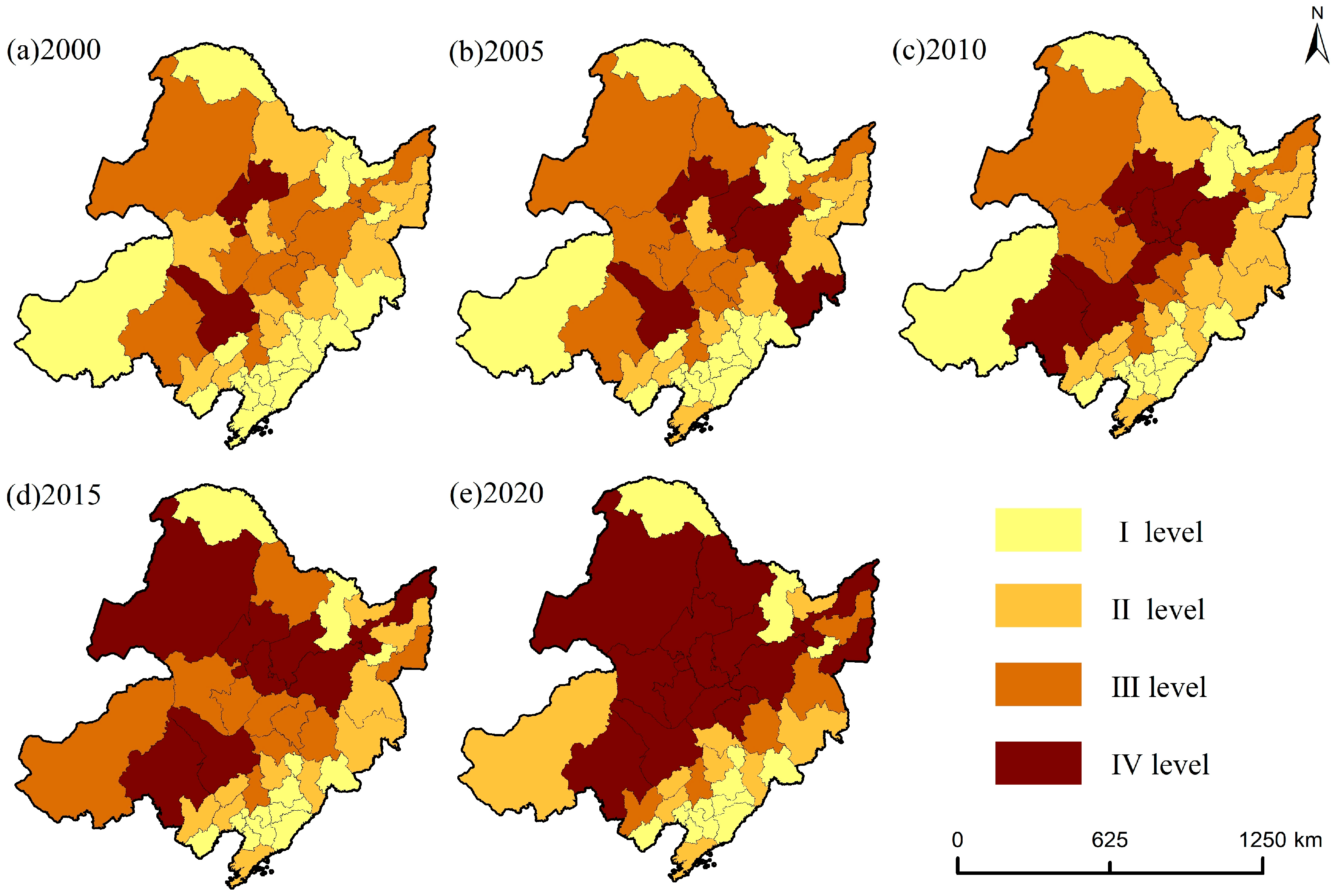


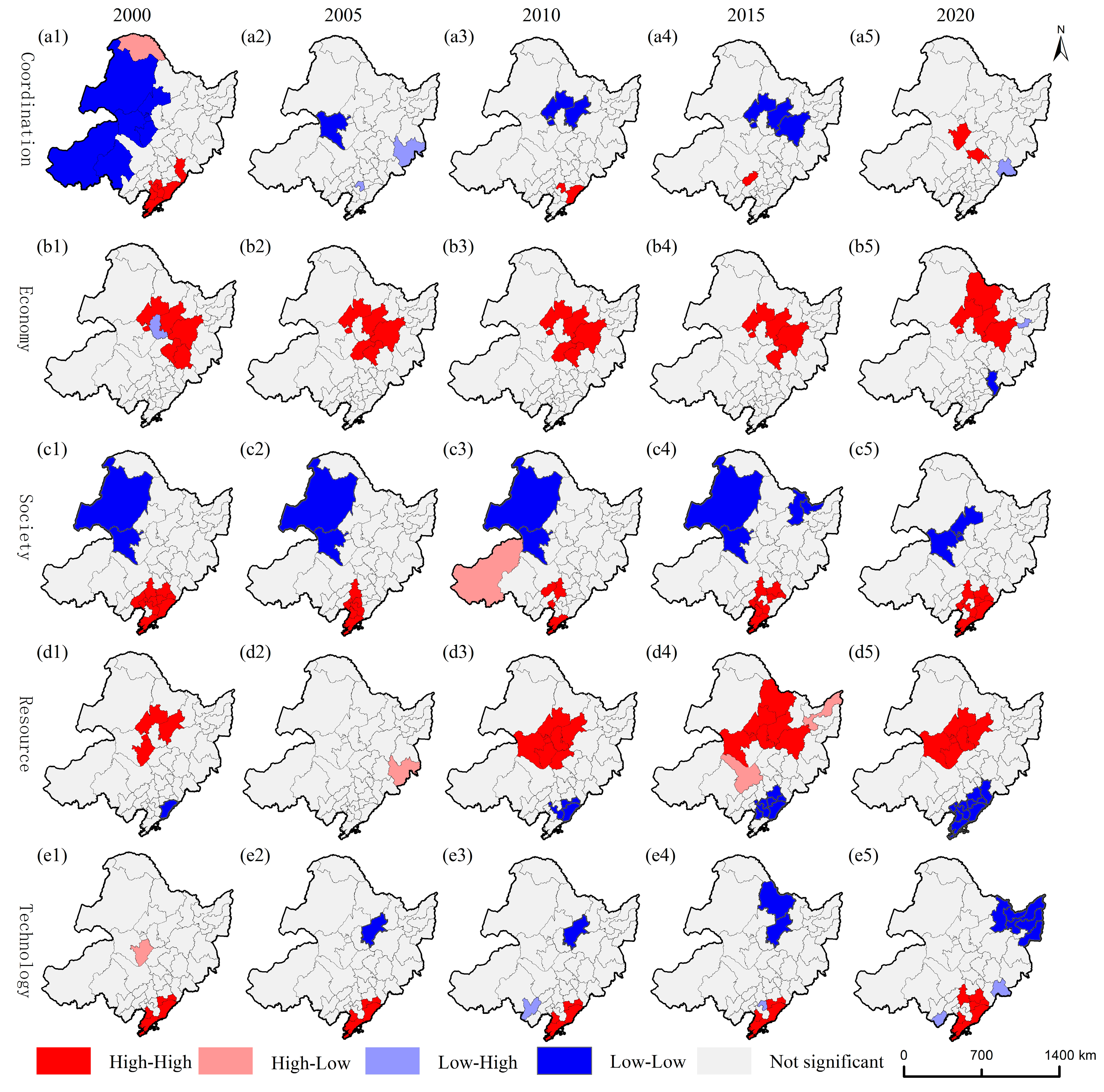
| Target Layers | Criterion Layers | Index Layers | Target Directions | Formulae and Units | Index Weights | Connotation |
|---|---|---|---|---|---|---|
| Sustainable Agricultural Development | economic subsystem | Agricultural output value | + | (billion yuan RMB) | 0.1283 | This index reflects the state of the agricultural economy. |
| Average per capita net income of farmers | + | (yuan RMB/person) | 0.0829 | This index reflects the average income level of rural residents. | ||
| Land productivity | + | Agricultural output/crop sowing area (%) | 0.0823 | This index comprehensively reflects the level of land productivity. | ||
| Total food production | + | (ton) | 0.1323 | This index reflects the level of food supply. | ||
| social subsystem | Urbanization rate | + | (%) | 0.0649 | This index reflects the degree of regional urbanization. | |
| Average housing area per capita in rural areas | + | (m2) | 0.0287 | This index reflects the living security situation of rural residents. | ||
| Rural per capita electricity consumption | + | Electricity consumption in rural areas/rural population (kwh/person) | 0.1384 | This index reflects the living standards of rural residents. | ||
| resource subsystem | Land area for cultivation | + | (1000 ha) | 0.1413 | This index reflects the abundance of regional cultivated land resources. | |
| Effective irrigation area | + | (1000 ha) | 0.1202 | This index reflects the ability of agriculture to resist natural disasters. | ||
| Number of individuals employed in the agricultural sector | − | (million person) | 0.0160 | This index reflects the intensification of cultivated land use. | ||
| technology subsystem | Intensity of fertilizer application | − | Fertilizer application rate/crop sowing area (kg/ha) | 0.0155 | This index reflects the level of fertilizer application. | |
| Efficiency level of agricultural machinery | + | Total power of agricultural machinery/crop sowing area (kwh/ha) | 0.0457 | This index reflects the degree of rural mechanization. | ||
| Intensity of pesticide application. | − | Pesticide application rate/crop sowing area (kg/ha) | 0.0035 | This index reflects the level of pesticide application. |
| Data Type | Obs | Mean | Max | Min | Std. Dev. |
|---|---|---|---|---|---|
| Agricultural output value (billion yuan RMB) | 205 | 114.050 | 745.500 | 5.000 | 120.320 |
| Average per capita net income of farmers(yuan RMB/person)) | 205 | 8354.220 | 21,729.000 | 1008.000 | 5665.020 |
| Land productivity (%) | 205 | 22.310 | 110.260 | 2.230 | 17.070 |
| Total food production (ton) | 205 | 293.520 | 1449.390 | 8.190 | 310.720 |
| Urbanization rate (%) | 205 | 14.280 | 73.880 | 2.720 | 9.150 |
| Average housing area per capita in rural areas (m2) | 205 | 25.610 | 40.600 | 13.800 | 5.340 |
| Rural per capita electricity consumption (kwh/person) | 205 | 0.070 | 0.540 | 0.003 | 0.080 |
| Land area for cultivation (1000 ha) | 205 | 738.340 | 10,990.000 | 48.000 | 939.822 |
| Effective irrigation area (1000 ha) | 205 | 178.570 | 955.500 | 0.810 | 180.648 |
| Number of individuals employed in the agricultural sector (million person) | 205 | 69.150 | 223.620 | 1.760 | 48.93 |
| Intensity of fertilizer application (kg/ha) | 205 | 558.560 | 1688.060 | 45.000 | 351.32 |
| Efficiency level of agricultural machinery (kwh/ha) | 205 | 4.330 | 12.110 | 0.757 | 2.11 |
| Intensity of pesticide application (kg/ha) | 205 | 10.530 | 80.460 | 0.890 | 9.82 |
| Time | Type | Economic Subsystem | Social Subsystem | Resource Subsystem | Technology Subsystem | Sustainable Agricultural Development System |
|---|---|---|---|---|---|---|
| 2000 | Moran’s I | 0.065 | 0.317 | 0.173 | 0.101 | 0.030 |
| P | 0.069 | 0.000 | 0.000 | 0.012 | 0.278 | |
| Z | 1.818 | 6.773 | 3.862 | 2.510 | 1.085 | |
| 2005 | Moran’s I | 0.109 | 0.284 | 0.045 | 0.220 | 0.030 |
| P | 0.008 | 0.000 | 0.070 | 0.000 | 0.229 | |
| Z | 2.655 | 6.105 | 1.809 | 4.840 | 0.030 | |
| 2010 | Moran’s I | 0.100 | 0.218 | 0.283 | 0.190 | 0.147 |
| P | 0.061 | 0.000 | 0.000 | 0.000 | 0.001 | |
| Z | 1.870 | 4.930 | 5.962 | 4.220 | 3.377 | |
| 2015 | Moran’s I | 0.108 | 0.296 | 0.249 | 0.205 | 0.076 |
| P | 0.008 | 0.000 | 0.000 | 0.000 | 0.044 | |
| Z | 2.671 | 6.321 | 5.328 | 4.546 | 2.014 | |
| 2020 | Moran’s I | 0.120 | 0.306 | 0.300 | 0.268 | 0.004 |
| P | 0.004 | 0.000 | 0.000 | 0.000 | 0.569 | |
| Z | 2.847 | 6.557 | 6.323 | 5.685 | 0.569 |
Disclaimer/Publisher’s Note: The statements, opinions and data contained in all publications are solely those of the individual author(s) and contributor(s) and not of MDPI and/or the editor(s). MDPI and/or the editor(s) disclaim responsibility for any injury to people or property resulting from any ideas, methods, instructions or products referred to in the content. |
© 2023 by the authors. Licensee MDPI, Basel, Switzerland. This article is an open access article distributed under the terms and conditions of the Creative Commons Attribution (CC BY) license (https://creativecommons.org/licenses/by/4.0/).
Share and Cite
Yang, G.; Yan, H.; Li, Q. Coordination Analysis of Sustainable Agricultural Development in Northeast China from the Perspective of Spatiotemporal Relationships. Sustainability 2023, 15, 16354. https://doi.org/10.3390/su152316354
Yang G, Yan H, Li Q. Coordination Analysis of Sustainable Agricultural Development in Northeast China from the Perspective of Spatiotemporal Relationships. Sustainability. 2023; 15(23):16354. https://doi.org/10.3390/su152316354
Chicago/Turabian StyleYang, Guang, Hua Yan, and Quanfeng Li. 2023. "Coordination Analysis of Sustainable Agricultural Development in Northeast China from the Perspective of Spatiotemporal Relationships" Sustainability 15, no. 23: 16354. https://doi.org/10.3390/su152316354





